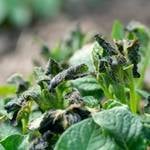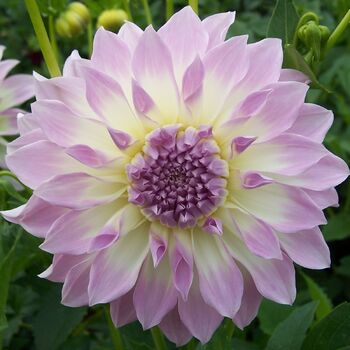
How to Grow Dahlia Tubers
Grow Guide #2262
Family: Asteraceae
Binomial name: Dahlia hybrid
Life Cycle: Perennial
This 'How to Grow' guide details everything a home gardener needs to know to plant, grow and care for Dahlias (Dahlia hybrid).
(This guide provides instructions on how to grow dahlias from tubers. Tubers are the swollen roots of dahlia plants that are dug up, divided and sold bare rooted (without soil). Dahlias can also be grown from seed. To learn how to grow from seed, click here.)
When to Plant Dahlia Tubers
Dahlia tubers can be planted in spring and early summer after all danger of frost has passed. Use the table below to identify the best time of year to plant dahlia tubers in your climate.
| JAN | FEB | MAR | APR | MAY | JUN | JUL | AUG | SEP | OCT | NOV | DEC | |
|---|---|---|---|---|---|---|---|---|---|---|---|---|
| Cool | ||||||||||||
| Temperate | ||||||||||||
| Sub-Tropical | ||||||||||||
| Tropical | ||||||||||||
| Arid |
Preparation
Dahlia plants are best grown in full sun or part shade. Choose a location that will receive at least 3 hours of full sun each day.
Dahlia plants need a well drained soil enriched with plenty of organic matter. Prepare soil by weeding it thoroughly, digging it over to loosen it and adding aged animal manure or compost. Keep the area free of weeds until planting. Learn more about preparing soil for planting here.
Dahlia plants can be grown in containers. If possible choose a variety that’s recommended for container growing. Use a good quality potting mix and make sure your container is large enough for mature plants; a minimum of 40 litres is recommended for dahlias. During the growing season, keep in mind that container grown plants may need additional fertiliser to encourage healthy growth.
How to Plant Dahlia Tubers
Do not plant until all danger of frost has passed. If storing tubers prior to planting, remove them from the bag and keep them in a cardboard box covered with just-damp coir, sawdust or potting mix. Check tubers regularly for signs of rot.
Tubers can be planted when dormant, when the 'eyes' show first signs of growth or when shoots are visible. Some gardeners like to wait until they see growth before planting so they can be sure the tuber is viable. If shoots are damaged they can be cut off with a clean, sharp knife; new shoots will grow from the 'eyes'.
- Dig a 10-15cm deep hole and plant the tuber horizontally with the 'eye' or shoot pointing upwards.
- Cover with soil; unless soil is very dry do not water until shoots are approximately 15cm tall.
- Place a sturdy stake next to the tuber to support the plant as it grows.
- Space tubers 40cm apart.
- Protect shoots from slugs and snails
How to Grow Dahlia
Watering before shoots emerge from the soil can cause tubers to rot; do not water until shoots are approximately 15cm tall. Dahlia plants may need watering during the growing season. Water when the soil is dry about 5cm below the surface (test this by scratching away a little soil with your finger). Water deeply in the early morning or late afternoon. Avoid watering the leaves of plants to avoid fungal diseases. Learn more about watering here.
If soil was well prepared no extra fertiliser should be necessary. In poor soil or to give your plants an extra boost, application of a high-potassium fertiliser or one formulated for flowering plants can be beneficial:
- Apply slow release fertiliser at the recommended rate when transplanting or when seedlings are 5-10cm tall.
- Apply liquid fertiliser at the recommended rate and frequency while plants are fruiting or flowering.
Dahlia plants may need to be supported as they grow. Depending on the expected size and height of the plant, use a stake, bamboo cane, trellis or string lines to support plants. Make sure you have the support in place when you sow seed or transplant seedlings to avoid disturbing the plant's roots later.
Optional: Pinch out the growing tips of dahlia plants to encourage denser growth with stronger stems and more flowers. Using sharp secateurs or snips remove the top set of leaves, cutting just above a set of lower leaves.
Dahlia plants should flower in approximately 90-120 days.
Deadhead dahlia flowers regularly during the growing season. Using sharp secateurs or snips cut fading or dead flowers off just above a set of leaves. Removing old flowers regularly will encourage plants to produce more flowers. Learn more about deadheading flowering plants here.
If growing dahlias for cut flowers, use sharp snips or secateurs to cut the longest stems possible, removing the lower leaves and placing the stems immediately in a clean bucket of water. Learn more about cutting and conditioning homegrown flowers here.
When plants have finished flowering prune stems to half their height. When leaves begin to change colour in autumn or winter, prune stems to 10cm above ground level.
Tubers can be left in the ground over winter in very well drained soil, but will benefit from being lifted and divided every second year. Use a garden fork to gently lift the entire plant and wash off the excess soil. Using clean, sharp snips or secateurs, divide the tubers, retaining part of the old stalk and making sure there is at least one eye per tuber. Store tubers horizontally in just-damp potting mix, sawdust or coir until replanting.
Common Problems when Growing Dahlias
Like all plants, dahlia is susceptible to some pests, diseases and other problems. Below is a list of the most common problems gardeners encounter when growing dahlia plants:
 Aphids are small (2-4mm long) sap-sucking insects that congregate on the new shoots or the undersides of leaves. They can cause leaves to wilt or become discoloured, and also excrete honeydew which can attract ants and other insect pests. To manage aphids, remove them by spraying with a garden hose, apply a soap or alcohol spray, or encourage predatory insects to your garden. Read more about aphids here.
Aphids are small (2-4mm long) sap-sucking insects that congregate on the new shoots or the undersides of leaves. They can cause leaves to wilt or become discoloured, and also excrete honeydew which can attract ants and other insect pests. To manage aphids, remove them by spraying with a garden hose, apply a soap or alcohol spray, or encourage predatory insects to your garden. Read more about aphids here. Grey mould (Botrytis sp.) is a fungal disease that causes flowers to become mouldy and fruit to rot. Spores are transported by wind and can survive in soil or on green waste. The fungus spreads most in cool, damp weather. Prune off affected flowers and fruit, water plants at soil level (not on leaves) and if necessary spray with an appropriate fungicide or homemade spray.
Grey mould (Botrytis sp.) is a fungal disease that causes flowers to become mouldy and fruit to rot. Spores are transported by wind and can survive in soil or on green waste. The fungus spreads most in cool, damp weather. Prune off affected flowers and fruit, water plants at soil level (not on leaves) and if necessary spray with an appropriate fungicide or homemade spray. Frost damage can cause leaves to wilt and go black. Do not plant seedlings in the garden until all danger of frost has passed in spring, and harvest plants before winter. Prune all frost-damaged leaves to avoid them rotting on the plant.
Frost damage can cause leaves to wilt and go black. Do not plant seedlings in the garden until all danger of frost has passed in spring, and harvest plants before winter. Prune all frost-damaged leaves to avoid them rotting on the plant..jpg) Powdery mildew is caused by fungal spores reproducing on the leaves of plants. First showing as white spots on leaves, affected areas can spread quickly to cover the entire leaf surface. While rarely fatal, powdery mildew can reduce yields. Water plants at soil level (not on leaves) to prevent spreading spores, allow good air flow between plants, remove affected leaves and if necessary spray with an appropriate fungicide or homemade spray. Read more here about powdery mildew here.
Powdery mildew is caused by fungal spores reproducing on the leaves of plants. First showing as white spots on leaves, affected areas can spread quickly to cover the entire leaf surface. While rarely fatal, powdery mildew can reduce yields. Water plants at soil level (not on leaves) to prevent spreading spores, allow good air flow between plants, remove affected leaves and if necessary spray with an appropriate fungicide or homemade spray. Read more here about powdery mildew here.%20(2).jpg) Rotten tubers are caused by pathogens entering tubers after sitting in cold, wet soil or being temporarily waterlogged. Tubers may show obvious signs of rot, have no roots or shoots, or produce stunted yellow leaves. Plant tubers in free-draining soil, raised garden beds or containers, and do not water them until shoots emerge. In heavy soils, lift and store tubers over winter and replant in spring.
Rotten tubers are caused by pathogens entering tubers after sitting in cold, wet soil or being temporarily waterlogged. Tubers may show obvious signs of rot, have no roots or shoots, or produce stunted yellow leaves. Plant tubers in free-draining soil, raised garden beds or containers, and do not water them until shoots emerge. In heavy soils, lift and store tubers over winter and replant in spring. Slugs and snails are molluscs that feed on tender leaves and shoots, mostly at night, leaving slimy trails behind them. Control them by removing their hiding places, keeping free range poultry, collecting them by torchlight or by placing traps. Read more about slugs and snails here.
Slugs and snails are molluscs that feed on tender leaves and shoots, mostly at night, leaving slimy trails behind them. Control them by removing their hiding places, keeping free range poultry, collecting them by torchlight or by placing traps. Read more about slugs and snails here. Thrips are black, beige or white flying insects (<1.5mm) with larvae that suck tissue from leaves and petals, leaving behind very small white or transparent markings. While not usually causing serious damage, the marks affect the look of flowers and foliage and thrips can also transfer pathogens from one plant to another. Wash thrips from affected plants using a garden hose, encourage predatory mites and lacewings with companion planting, or spray with soap, eco-oil or neem oil.
Thrips are black, beige or white flying insects (<1.5mm) with larvae that suck tissue from leaves and petals, leaving behind very small white or transparent markings. While not usually causing serious damage, the marks affect the look of flowers and foliage and thrips can also transfer pathogens from one plant to another. Wash thrips from affected plants using a garden hose, encourage predatory mites and lacewings with companion planting, or spray with soap, eco-oil or neem oil.


.png)






